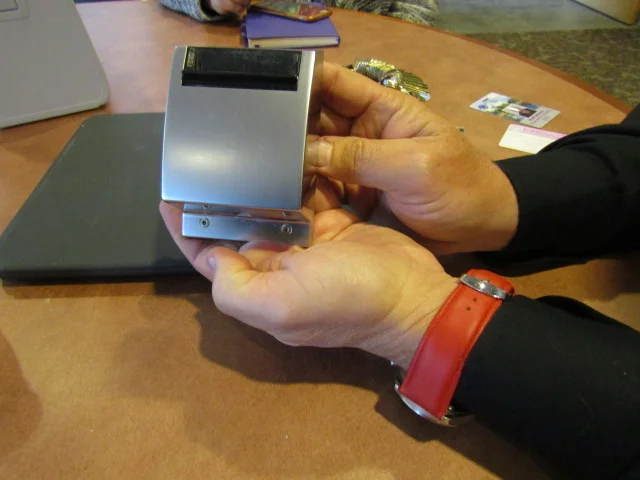OPINION: A Need For Universal Design
The Subtle Exclusion of People with Disabilities on College Campuses
Pictured above: Alma Silver working on a research project using her adaptive technology.
Looking back on my early years at St. Catherine University, I remember a time when I felt like an outsider.
I entered the classroom one afternoon and parked my wheelchair under the table. My personal care attendant arranged my speech-generating device and adapted laptop equipment as I reviewed the assignments on the syllabus. After I flipped to the policy page, my stomach sunk as I read the bold and unforgiving heading: No-Laptop Policy.
Several phrases in the policy explanation delivered particularly hard blows, including “unnecessary,” “distraction to peers,” and “diminished comprehension due to typing.” In the following class periods, I ignored these rules. If I cannot type, I cannot express my voice.
Unfortunately, similarly isolating experiences in later semesters opened my eyes to the unacknowledged ableism underlying such policies. Many procedures and dialogues carried out by academic communities fundamentally exclude students with disabilities. More inclusive practices and language must be realized on all college campuses, including St. Kate’s, to holistically embrace disability and neurodiversity. Both faculty and students must work together to create an accessible community for all students.
Inclusion stems from implementing universal design within classrooms. Universal design encompasses broad-spectrum ideas meant to create accessible environments for all, including students with invisible disabilities. Universal design on campuses should extend beyond curb cuts and door openers. At their best, universally designed classrooms welcome diverse learning styles. They include features such as flexible work spaces, provision of texts in accessible formats, and multiple assignment options for students to prove competencies.
Universal designs reinforces that all students are welcomed and supported in any learning environment that they wish to access.
Universal design clearly emerges when professors welcome the appropriate use of technology for note-taking rather than generalizing it as a distraction. Technology allowances recognize personalized communication methods and engagement strategies used by students with physical and learning disabilities. It embraces diverse forms of expression and augmentative speech that too often become overlooked in conversations about inclusion.
New branches of research challenge the traditional conclusions that technology diminishes comprehension. According to a 2017 study conducted by Ruth Colker, an Ohio State University law professor, laptop usage had no significant impact on students test scores when researchers conducted empirical studies in a genuine classroom setting rather than a simulated environment. Beyond their ineffectiveness, no-laptop policies assume the uniform presence of neurotypical students, placing the responsibility of accommodation on students with disabilities. Professors must accommodate for evolving communication and learning tools while designing their classes.
In addition to universal design, the disability community must be equally represented in the social and cultural narratives explored within classrooms at St. Kate’s in order to truly fulfill our mission of embracing diversity. Mindful word choices are essential for students with disabilities to be as equally integrated into discussions as other minority populations. Therefore, both professors and students must be better trained on avoiding usage of outdated terminology, such as “handicapped” and ”mental retardation,” within lectures and presentations. Tremendous influence also stems from awareness of the non-disabled frameworks underlying commonplace phrases, which frequently become used in reference to shared activities at St. Kate’s. Some of these phrases include “standing up” to injustice and “walking across the stage” at graduation. Even subtle language holds the power to either ostracize students with disabilities or respect them as valued members of intellectual communities.
Within classrooms, broader inclusion can be modeled in dialogues exploring intersectionality. Disabilities must be framed as intricately linked to other dimensions of a person’s identity such as gender, race, class, and sexual orientation. Regardless of who is present in the classroom, disabilities must be openly discussed as natural elements of diversity in order to challenge assumptions and foster awareness. Progress toward community-wide inclusion stems directly from the dialogue that is fostered both inside and outside of the classroom.
I am grateful that energy continues to grow in the St. Kate’s community around creating an accessible and inclusive learning environment. Throughout the month of October, the university’s newly formed Neurodiversity Task Force will hold two focus groups that invite College for Women students identifying as having neurodiverse traits to share their experiences and suggestions for improving campus culture. Progress toward inclusion should extend beyond these conversations and continuously encompass all sectors of campus life.
We can all take collaborative actions to welcome students with disabilities. Universal design and equal representation ultimately form the groundwork from which inclusive mindsets will grow. The disability community must be included in initiatives to improve environments and dialogues. The small steps matter in creating a future in which nobody feels like an outsider.
(Note: For more information about the neurodiversity focus groups, please contact Professor Susan Hawthorne at schawthorne@stkate.edu.)






